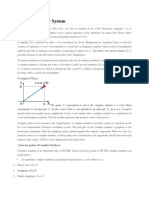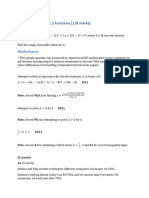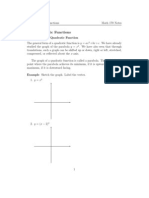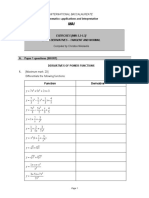100%(1)100% found this document useful (1 vote)
84 viewsFunction and Graph: Chapter 1.2 Properties of Function
This document discusses functions and their graphs. It provides examples of how to find the graph of a function by:
1) Determining the domain, or possible x-values that can be input into the function
2) Calculating the output or y-values f(x) by plugging domain values into the function
3) Plotting the coordinate pairs (x, f(x)) to graph the relationship between inputs and outputs
For instance, it shows how to graph y=x^2 by finding f(x) for x=-3 to x=3, determining the parabola shape. It emphasizes remembering common function graphs and finding domains and ranges to sketch graphs more quickly.
Uploaded by
SajalAhmedCopyright
© © All Rights Reserved
Available Formats
Download as PPT, PDF, TXT or read online on Scribd
100%(1)100% found this document useful (1 vote)
84 viewsFunction and Graph: Chapter 1.2 Properties of Function
This document discusses functions and their graphs. It provides examples of how to find the graph of a function by:
1) Determining the domain, or possible x-values that can be input into the function
2) Calculating the output or y-values f(x) by plugging domain values into the function
3) Plotting the coordinate pairs (x, f(x)) to graph the relationship between inputs and outputs
For instance, it shows how to graph y=x^2 by finding f(x) for x=-3 to x=3, determining the parabola shape. It emphasizes remembering common function graphs and finding domains and ranges to sketch graphs more quickly.
Uploaded by
SajalAhmedCopyright
© © All Rights Reserved
Available Formats
Download as PPT, PDF, TXT or read online on Scribd
You are on page 1/ 22
FUNCTION AND GRAPH
Chapter 1.2 PROPERTIES OF FUNCTION
Function
Lets assume we have a function :
Y = x
2
This function can be written as:
f(x) = x
2
Horizontal line
In graph will
represent
x axis and
Vertical line will
represent f(x)
Finding graph of a function
f(x) = x
2
Now, if
x = 0; thn f(0) = (0)
2
=0
x = 1; thn f(1) = (1)
2
=1
x = 2; thn f(2) = (2)
2
=4
x = 3; thn f(3) = (3)
2
=9
.
x = -1; thn f(-1) = (-1)
2
=1
x = -2; thn f(-2) = (-2)
2
=4
x = -3; thn f(-3) = (-3)
2
=9
..
Graph co-ordinates
So, the coordinates of x
2
are,
(x, f(x))
=(0,0), (1,1), (2,4), (3, 9), (-1,1), (-2,4), (-3, 9) as
far as u can go
DOMAIN
u can find out graph of any function u are given
using the method I just showed.
Assume a value of x and find out the value of f(x)
against tht value.
f(x) = x
2
x = 3; thn f(3) = (3)
2
=9
Here for a function like x
2
u can choose any value of x.
HOWEVER,,, some functions has limitation, u can not just put any
value for x.
For example :
How to find domain
f(x) =
Value of x MUST
BE POSITIVE;
f(x)=
Value of x MUST NOT
BE ZERO;
1. Value inside square-root must be POSITIVE
(cz square-root cant process negative numbers
2. Denominator must not be ZERO
Example:
Find the Domain of the following equations:
y
2
+ x
2
= 25
Solution:
y
2
+ x
2
= 25
y
2
= 25 - x
2
y = +
f(x)= | |
so,
25 - x
2
> 0
x
2
<25
x < +5
x < |5|
So value of x
will be equal
or less thn 5
and more thn -5
NOTE:
In calculus we write +a as |a|
So, |a| = a & -a
RULES:
|-a| = |a|
|ab| = |a| |b|
|a/b| = |a| / |b| (b must not be ZERO)
|a+b| < |a| + |b|
..continuation of previous slide
value of x will be equal to 5 or less thn 5 and
more thn -5 can e written as
-5<x<5
So,
f(x) = | | = & -
So you have to find f(5), f(4), f(3), f(2), f(1), f(0), f(-1), f(-2), f(-3), f(-4),
f(-5)
For both & -
DO YOURSELF
..continuation of previous slide
HINTS:
FOR,
FOR, -
find f(5), f(4), f(3), f(2), f(1), f(0), f(-1), f(-2), f(-3), f(-4), f(-5) For and
draw the graph AND
find f(5), f(4), f(3), f(2), f(1), f(0), f(-1), f(-2), f(-3), f(-4), f(-5) For - and
draw the graph
U can chk previous slide no 3 for more details
THE GRAPH OF THE MATH WILL LOOK
LIKE THIS:
Summary
Find f(x) from y
2
+ x
2
= 25
Which is f(x)= | |
Find domain of x which is -5<x<5
means , find f(x) for x = - 5, -4,-3, -2, -1, 0, 1, 2, 3, 4,
5
Which is f(-5), f(-4).f(0)..f(4), f(-5)
For both & -
And draw graph for each of them
DURING EXAM U WILL GET MAX 5 MINS TO COMPLETE ALL THESE STEPS
SO U NEED TO KNW THE properties of graphs..TO FINISH THIS MATH MORE
QUICKLY .
Properties of graph.
x , x
2
, x
3,
, 1/x, sin x, cos x, tanx,
All of them has different type of shapes whn u
convert them into graph.
JUST REMEMBER THIS SHAPES OF GRAPHS
ACCORDING TO THEIR EQUATIONS.
ONCE U SEE AN EQUATION, IF CAN REMEMER
THE PROPERTIES , U CAN IMAGINE HOW THE
GRAPH WILL LOOK LIKE..
SO JUST FIND DOMAIN & RANGE, put them into
the graph and draw the shape..u dnt hav to go to
every single coordinate to find the shape.
DOMAIN & RANGE
IF
f(x)=
THN, domain : -5<x<5
And range : f(-5) < f(x) <f(5)
HOMEWORK
Find domain range and graph for :
a.) y = 1/(x-5)
b) y = (1/x) -5
c) y
2
= x
2
-4
d) y = 9 - x
2
Tricky Example:
f(x) = (x
2
- 4) / (x-2)
f(x) = (x
2
- 4) / (x-2)
= (x - 2) (x+2) / (x-2)
= x + 2
so, f(x) = x+2
this is the tricky part.. u can put any value for x when f(x) = x+2;
BUT..
our main function is f(x) = (x
2
- 4) / (x-2)
HERE, x MUST NOT BE 2. cz if x = 2 thn denominator is is 2-2 = 0.
so... even though f(x) = x+2 , domain is any value of X except 2.
Example: DRAW THE GRAPH of f(x)
this math, there are 3 conditions of f(x)
according to the value x.
solution:
..continuation of previous slide
so...
f(-3) = 0
f (-2) = 0
f(-1) = 0
f(0) = 1
f( 1) = 0
f(2) =2
f(3) =3
f(4) = 4
....
TRY these at home
find the graph of
f(x) = tanx (hints: tanx =sinx/cosx ; so cosx must NOT be 0)
((hints: x-1 > 0 so, x > 1...so find out f(1),
f(2)..till f() f(5) or, f(6)
You might also like
- Inverse Trigonometric Functions (Trigonometry) Mathematics Question BankFrom EverandInverse Trigonometric Functions (Trigonometry) Mathematics Question BankNo ratings yet
- Trigonometric Ratios to Transformations (Trigonometry) Mathematics E-Book For Public ExamsFrom EverandTrigonometric Ratios to Transformations (Trigonometry) Mathematics E-Book For Public Exams5/5 (1)
- AA SL 24 Revision Geometry and Trigonometry Part 2 MarkschemeNo ratings yetAA SL 24 Revision Geometry and Trigonometry Part 2 Markscheme46 pages
- Arithmetic & Geometric Sequence Reminder - IB Mathematics Diploma ProgrammeNo ratings yetArithmetic & Geometric Sequence Reminder - IB Mathematics Diploma Programme2 pages
- 2022 1MA2 Applications of Differentiation - Notes (Students)No ratings yet2022 1MA2 Applications of Differentiation - Notes (Students)21 pages
- The Function of Composition and InverseNo ratings yetThe Function of Composition and Inverse20 pages
- Chapter 4 Functions of Several VariablesNo ratings yetChapter 4 Functions of Several Variables25 pages
- PC FUNCTIONS End Behavior of Polynomial and Rational FunctioNo ratings yetPC FUNCTIONS End Behavior of Polynomial and Rational Functio16 pages
- Corepure1 Chapter 5::: Volumes of RevolutionNo ratings yetCorepure1 Chapter 5::: Volumes of Revolution19 pages
- MA (Improper Integrals & Comparison Test For Improper Integrals)No ratings yetMA (Improper Integrals & Comparison Test For Improper Integrals)5 pages
- AA HL Paper 1 Functions - Test - MarkschemeNo ratings yetAA HL Paper 1 Functions - Test - Markscheme27 pages
- Fall Prep Session Materials 2014-15 DraftNo ratings yetFall Prep Session Materials 2014-15 Draft216 pages
- Limit Theorems: By: Ivan Sutresno Hadi SujotoNo ratings yetLimit Theorems: By: Ivan Sutresno Hadi Sujoto19 pages
- 08 Matrices and Vector Analysis (Lesson 08)No ratings yet08 Matrices and Vector Analysis (Lesson 08)14 pages
- MATH2023 Multivariable Calculus Chapter 3 Partial Derivatives L2/L3 (Fall 2019)No ratings yetMATH2023 Multivariable Calculus Chapter 3 Partial Derivatives L2/L3 (Fall 2019)36 pages
- 9897 - Lesson Note On Linear and Quadratic GraphNo ratings yet9897 - Lesson Note On Linear and Quadratic Graph4 pages
- 2.2: Limit of A Function and Limit Laws: Learning ObjectivesNo ratings yet2.2: Limit of A Function and Limit Laws: Learning Objectives16 pages
- Gordon R Complex Integration A Compendium of Smart and LittlNo ratings yetGordon R Complex Integration A Compendium of Smart and Littl254 pages
- Full Download Geometric Group Theory An Introduction draft Clara Löh PDF DOCX100% (1)Full Download Geometric Group Theory An Introduction draft Clara Löh PDF DOCX55 pages
- 3.2-Properties of Analytic Function - 025514No ratings yet3.2-Properties of Analytic Function - 02551418 pages
- Exercise. 9 (A) : Class X Chapter 9 - Matrices Maths100% (1)Exercise. 9 (A) : Class X Chapter 9 - Matrices Maths49 pages
- 11.1 - Eigenvalue Problems for y'' + λy = 0 - Mathematics LibreTextsNo ratings yet11.1 - Eigenvalue Problems for y'' + λy = 0 - Mathematics LibreTexts5 pages
- Differential and Integral Calculus by Love Rainville Solutions Manual PDF100% (1)Differential and Integral Calculus by Love Rainville Solutions Manual PDF2 pages
- Signals and Sytems - TA2 - Laplace TransformNo ratings yetSignals and Sytems - TA2 - Laplace Transform2 pages
- Green's Functions For Neumann Boundary ConditionsNo ratings yetGreen's Functions For Neumann Boundary Conditions10 pages
- Chapter 2-Gamma Beta Functions (Part 1)No ratings yetChapter 2-Gamma Beta Functions (Part 1)67 pages
- Microsoft Word - (Mai 5.2-5.3) Basic Derivatives - Tangent and NormalNo ratings yetMicrosoft Word - (Mai 5.2-5.3) Basic Derivatives - Tangent and Normal18 pages
- Image Enhancement by Elliptic Discrete Fourier Transforms: Artyom M. Grigoryan Sos S. AgaianNo ratings yetImage Enhancement by Elliptic Discrete Fourier Transforms: Artyom M. Grigoryan Sos S. Agaian10 pages
- Inverse Trigonometric Functions (Trigonometry) Mathematics Question BankFrom EverandInverse Trigonometric Functions (Trigonometry) Mathematics Question Bank
- Trigonometric Ratios to Transformations (Trigonometry) Mathematics E-Book For Public ExamsFrom EverandTrigonometric Ratios to Transformations (Trigonometry) Mathematics E-Book For Public Exams
- AA SL 24 Revision Geometry and Trigonometry Part 2 MarkschemeAA SL 24 Revision Geometry and Trigonometry Part 2 Markscheme
- Arithmetic & Geometric Sequence Reminder - IB Mathematics Diploma ProgrammeArithmetic & Geometric Sequence Reminder - IB Mathematics Diploma Programme
- 2022 1MA2 Applications of Differentiation - Notes (Students)2022 1MA2 Applications of Differentiation - Notes (Students)
- PC FUNCTIONS End Behavior of Polynomial and Rational FunctioPC FUNCTIONS End Behavior of Polynomial and Rational Functio
- MA (Improper Integrals & Comparison Test For Improper Integrals)MA (Improper Integrals & Comparison Test For Improper Integrals)
- MATH2023 Multivariable Calculus Chapter 3 Partial Derivatives L2/L3 (Fall 2019)MATH2023 Multivariable Calculus Chapter 3 Partial Derivatives L2/L3 (Fall 2019)
- 2.2: Limit of A Function and Limit Laws: Learning Objectives2.2: Limit of A Function and Limit Laws: Learning Objectives
- Gordon R Complex Integration A Compendium of Smart and LittlGordon R Complex Integration A Compendium of Smart and Littl
- Full Download Geometric Group Theory An Introduction draft Clara Löh PDF DOCXFull Download Geometric Group Theory An Introduction draft Clara Löh PDF DOCX
- Exercise. 9 (A) : Class X Chapter 9 - Matrices MathsExercise. 9 (A) : Class X Chapter 9 - Matrices Maths
- 11.1 - Eigenvalue Problems for y'' + λy = 0 - Mathematics LibreTexts11.1 - Eigenvalue Problems for y'' + λy = 0 - Mathematics LibreTexts
- Differential and Integral Calculus by Love Rainville Solutions Manual PDFDifferential and Integral Calculus by Love Rainville Solutions Manual PDF
- Microsoft Word - (Mai 5.2-5.3) Basic Derivatives - Tangent and NormalMicrosoft Word - (Mai 5.2-5.3) Basic Derivatives - Tangent and Normal
- Image Enhancement by Elliptic Discrete Fourier Transforms: Artyom M. Grigoryan Sos S. AgaianImage Enhancement by Elliptic Discrete Fourier Transforms: Artyom M. Grigoryan Sos S. Agaian
























































































